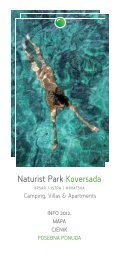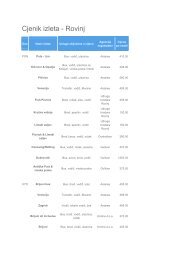Create successful ePaper yourself
Turn your PDF publications into a flip-book with our unique Google optimized e-Paper software.
Boje, mirisi i okusi | Colours, Smells and Tastes<br />
U suradnji s prirodom | In Cooperation with Nature<br />
omega-3 masnim kiselinama. Želite li ostati ili postati<br />
mladi i zdravi koristite je barem dva puta tjedno u<br />
vašoj ishrani.<br />
Mediteranski pečat<br />
Istarska kuhinja je sastavni dio mediteranske prehrane<br />
koja predstavlja opće prihvaćeni standard pravilne<br />
prehrane. Uvriježena definicija mediteranske prehrane<br />
kaže: “Osnovne karakteristike mediteranske prehrane<br />
su umjerena upotreba mesa, mlijeka, sira, visok unos<br />
složenih ugljikohidrata (krumpir, palenta, tijesto, riža),<br />
svježeg voća i povrća, redovito konzumiranje ribe i<br />
upotreba masti koja je gotovo sva sadržana u obliku<br />
maslinovog ulja.”<br />
Maslinovo ulje je nezaobilazan sastojak istarske<br />
kuhinje. U Istri raste tridesetak sorti maslina. Neke<br />
su se sorte kroz povijest udomaćile na istarskom<br />
području i u takvom obliku ne rastu nigdje drugdje, pa<br />
ih se s pravom naziva autohtonim istarskim sortama.<br />
Budući da su preživjele godine vrlo niskih temperatura,<br />
kojih je kroz povijest bilo više, i iz tog aspekta su<br />
interesantne za buduće širenje. Istarska maslinova ulja<br />
su među najcjenjenijima u Europi.<br />
Pršut, sir, skuta<br />
Nezaobilazan je i istarski pršut koji je, zbog<br />
specifičnosti pripreme i klimatskih uvjeta, jedinstven<br />
proizvod u ovom dijelu Mediterana. Istarski je pršut<br />
zaštićen geografskim podrijetlom po najstrožim<br />
kriterijima i nitko ga ne može proizvoditi bez potpunog<br />
zadovoljavanja ovih kriterija. Pod geografskim<br />
podrijetlom potrebno je naglasiti da je riječ o središnjoj<br />
Istri (barem 12 kilometara udaljenoj od obale).<br />
Nakon obrade, začinjavanja, držanja pod teretom i<br />
dimljenja na dimu od lovora, prva faza zrenja čini<br />
sušenje na zraku (oko 5 mjeseci), dok je druga faza<br />
daljnje sušenje u tamnoj prostoriji uz slabiji protok<br />
zraka (minimum trajanja 6-8 mjeseci), iako nije<br />
rijetkost da “zrenje” traje i 2 godine. Pršut se suši<br />
isključivo na buri, hladnom sjeveroistočnom vjetru.<br />
Nudi se kao predjelo, mada se može jesti i kao glavni<br />
obrok.<br />
Tradicija i običaji nalažu da se uz pršut služe ovčji sir<br />
i masline. Posebno je kvalitetan ovčji sir od mlijeka<br />
autohtone istarske ovce pramenke.<br />
variety of fish, which prepared in a number of ways<br />
can actually be a delicacy. It is also very healthy, as<br />
oily fish has extremely valuable nutritious substances,<br />
such as omega-3 fatty acids. If you want to remain<br />
or become young and healthy, use it at least twice a<br />
week as a part of your diet.<br />
Mediterranean Imprint<br />
Istrian cuisine is a part of the Mediterranean diet<br />
which represents a generally accepted standard<br />
of healthy eating. The conventional definition of<br />
Mediterranean diet says: “The basic aspect of a<br />
Mediterranean diet is the moderate use of meat, milk<br />
and cheese, a high amount of complex carbohydrates<br />
(potato, polenta, pastry, and rice), fresh fruit and<br />
vegetables, regular consummation of fish and the use<br />
of fats mostly in the form of olive oil”.<br />
Yes, an unavoidable ingredient of Istrian cuisine is<br />
definitely olive oil. There are about thirty varieties of<br />
olives in Istria. Some have domesticated themselves in<br />
the Istrian region through history, and as such cannot<br />
be found anywhere else in the world, therefore, they<br />
are rightfully called the autochthonous Istrian variety.<br />
As they have survived many years at low temperatures,<br />
which has happened often through history, they are<br />
of interest in terms of future propagation. Istrian olive<br />
oils are among the most appreciated in Europe.<br />
Prosciutto, Cheese and Ricotta<br />
Istrian prosciutto is also unavoidable, with its specific<br />
preparation and climatic conditions, it is a unique<br />
product in this part of the Mediterranean. Istrian<br />
prosciutto is protected with its geographical origin by<br />
the strictest criteria and nobody is allowed to produce<br />
it without completely satisfying these criteria. When it<br />
comes to geographical origin, it should be emphasized<br />
that we are talking about central Istria (at least 12<br />
kilometers inland from the coast).<br />
After treatment, spicing, holding under weight and<br />
smoking on laurel smoke, the first phase of maturing is<br />
drying in fresh air (about 5 months), the second phase<br />
is further drying in a dark room with scarce flow of<br />
air (minimally 6-8 months), although it is not rare for<br />
the maturation to last up to 2 years. It is then dried<br />
exclusively on bora, a cold north-eastern wind. It is<br />
offered as an hors-d’oeuvre, although alternatively,<br />
can be eaten as a main course.<br />
Treba istaći i posebnu vrstu sira koja se u Istri proizvodi - skutu -<br />
svježi kravlji i ovčji sir. Jede se obično s kruhom, ali se može jesti i sa<br />
svježim smokvama, kao što je bio običaj u prošlosti. Nekad se skuta<br />
sušila te se na taj način dobivao sir vrlo pikantnog okusa i posebne<br />
arome.<br />
Tartufi, šparoge<br />
Istra doista ima dugogodišnju tradiciju pripremanja raznih vrsta<br />
namirnica što je danas čini zanimljivom destinacijom za gurmane.<br />
Usto, poseban pečat daju neke samonikle biljke koje se obilno koriste<br />
u istarskoj kuhinji. Na prvom su mjestu za Istru nezaobilazni tartufi,<br />
posebno cijenjene gljive kojima je Istra jedno od glavnih staništa<br />
u Europi (kako bijelom tako i crnom tartufu). Uz tartufe dolaze i<br />
šparoge. Koriste se samo mladi izdanci. Šparoge rastu samoniklo na<br />
livadama, proplancima, uz puteve i živice i na kamenjaru u primorskim<br />
krajevima. Izdanci kultivirane samonikle šparoge vrlo su ukusno i<br />
delikatesno povrće. U Istri se šparoge spravljaju na desetke načina, te<br />
sve više postaju nezaobilazan sastojak visoke, kreativne kuhinje, baš<br />
kao i tartufi.<br />
Tradition and customs say that prosciutto is usually served with ewe’s<br />
cheese and olives. Ewe’s cheese made from autochthonous Istrian<br />
sheep pramenka has special quality. We should also point out a<br />
special kind of cheese made in Istria, called ricotta - fresh cow’s and<br />
ewe’s cheese. It is usually eaten with bread, but it can also be eaten<br />
with fresh figs, as in the past. There was a time when ricotta used<br />
to be dried in order to produce cheese of a very sharp taste with a<br />
particular aroma.<br />
Truffles, Asparagus<br />
Istria truly has a long tradition of preparing various ingredients, which<br />
today makes it a very intriguing gourmet destination. Additionally,<br />
some wild plants abundantly used in Istrian cuisine give it a special<br />
imprint. Firstly, there are the unavoidable Istrian truffles, highly<br />
esteemed mushrooms with one of their main habitats in Istria (the<br />
highly valued white truffle, as well as the black truffle). Asparagus<br />
come with truffles. Only the young white shoots are used. They grow<br />
wildly on meadows, clearings, alongside paths and hedges and on<br />
rocky ground in coastal areas. The shoots of cultivated wild asparagus<br />
are a very tasty and delicious vegetable. In Istria asparagus are<br />
made in a number of ways, and they are becoming an unavoidable<br />
ingredient of haut creative cuisine, just like the truffles.<br />
62<br />
63

















